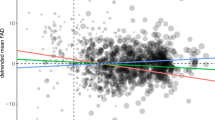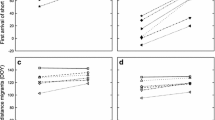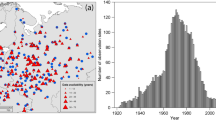Abstract
Long-term phenological data have been crucial at documenting the effects of climate change in organisms. However, in most animal taxa, time series length seldom exceeds 35 years. Therefore, we have limited evidence on animal responses to climate prior to the recent warm period. To fill in this gap, we present time series of mean first arrival dates to Central Europe for 13 bird species spanning 183 years (1828–2010). We found a uniform trend of arrival dates advancing in the most recent decades (since the late 1970s). Interestingly, birds were arriving earlier during the cooler early part of the nineteenth century than in the recent warm period. Temperature sensitivity was slightly stronger in the warmest 30-year period (−1.70 ± SD 0.47 day °C−1) than in the coldest period (−1.42 ± SD 0.89 day °C−1); however, the difference was not statistically significant. In the most recent decades, the temperature sensitivity of both short- and long-distance migrants significantly increased. Our results demonstrate how centennial time series can provide a much more comprehensive perspective on avian responses to climate change.




Similar content being viewed by others
References
Ahas R (1999) Long-term phyto-, ornitho- and ichthyophenological time-series analyses in Estonia. Int J Biometeorol 42:119–123
Ambrosini R, Rubolini D, Møller AP, Bani L, Clark J, Karcza Z, Vangeluwe D, du Feu C, Spina F, Saino N (2011) Climate change and the long-term northward shift in the African wintering range of the barn swallow Hirundo rustica. Clim Res 49:131–141
Askeyev OV, Sparks TH, Askeyev IV (2009) Earliest recorded Tatarstan skylark in 2008: non-linear response to temperature suggests advances in arrival dates may accelerate. Clim Res 38:189–192
Beklová M (1975) Ankuft und Abzug der tschechoslowakischen Population Hirundo rustica, Delichon urbica und Apus apus. Folia Zool 24:21–42
Beklová M, Pikula J, Šabatka L (1983) Phenological maps of bird migration. Acta Sc Nat Brno 17:1–47
Berthold P (1996) Control of bird migration. Chapman & Hall, London
Berthold P, Helbig AJ, Mohr G, Querner U (1992) Rapid microevolution of migratory behaviour in a wild bird species. Nature 360:668–670
Bitterlin LR, van Buskirk J (2014) Ecological and life history correlates of changes in avian migration timing in response to climate change. Clim Res 61:109–121
Both C (2007) Comment on “Rapid advance of spring arrival dates in long-distance migratory birds”. Science 315:598
Both C, Van Asch M, Bijlsma RG, Van den Burg AB, Visser ME (2009) Climate change and unequal phenological changes across four trophic levels: constrains or adaptations? J Anim Ecol 78:73–83
Both C, Van Turnhout CAM, Bijlsma RG, Siepel H, Van Strien AJ, Foppen RPB (2010) Avian population consequences of climate change are most severe for long-distance migrants in seasonal habitats. Proc R Soc B 277:1259–1266
Both C, Visser ME (2001) Adjustment of climate change is constrained by arrival date in a long-distance migrants. Nature 411:296–298
Brázdil R, Bělínová M, Rožnovský J (2011) Phenological observations made by the I. R. Bohemian Patriotic–Economic Society, 1828–1847. Theor Appl Climatol 105:71–81
Brázdil R, Bělínová M, Dobrovolný P (2012) Temperature and precipitation fluctuations in the Czech lands during the instrumental period. Masarykova Univerzita, Brno
Chambers LE, Altwegg R, Barbraud C, Barnard P, Beaumont L, Crawford R, Durrant JM, Hughes L, Keatley MR, Low M, Morellato LPC, Poloczanska E, Ruoppolo V, Vansteels R, Woehler E, Wolfaardt A (2013) Changes in southern hemisphere phenology. PLoS One 8:e75514
Dunn PO, Møller AP (2014) Changes in breeding phenology and population size of birds. J Anim Ecol 83:729–739
Ellwood ER, Primack RB, Talmadge ML (2010) Effects of climate change on spring arrival times of birds in Thoreau’s Concord from 1851 to 2007. Condor 112:754–762
Ellwood ER, Diez JM, Ibáῆez I, Primack RB, Kobori H, Higuchi H, Silander JA (2012) Disentangling the paradox of insect phenology: are temporal trends reflecting the response to warming? Oecologia 168:1161–1171
Finch T, Pearce-Higgins JW, Leech DI, Evans KL (2014) Carry-over effects from passage regions are more important than breeding climate in determining the breeding phenology and performance of three avian migrants of conservation concern. Biodivers Conserv 23(10):2427–2444
Fu YH, Zhao H, Piao S, Peaucelle M, Peng S, Zhou G, Ciais P, Huang M, Menzel A, Peñuelas J, Song Y, Vitasse Y, Zeng Z, Janssens IA (2015) Declining global warming effects on the phenology of spring leaf unfolding. Nature 526:104–107
Goodenough AE, Fairhurst SM, Morrison JB, Cade M, Morgan PJ (2015) Quantifying the robustness of first arrival dates as a measure of avian migratory phenology. Ibis 157:384–390
Gordo O (2007) Why are bird migration dates shifting? A review of weather and climate effects on avian migratory phenology. Clim Res 35:37–58
Gordo O, Doi H (2012) Drivers of population variability in phenological responses to climate change in Japanes birds. Clim Res 54:95–112
Gordo O, Sanz JJ (2005) Phenology and climate change: a long-term study in a Mediterranean locality. Oecologia 146:484–495
Gordo O, Sanz JJ, Lobo JM (2007) Environmental and geographical constraints on common swift and barn swallow spring arrival patterns throughout the Iberian Peninsula. J Biogeogr 34:1065–1076
Gordo O, Tryjanowski P, Kosicki JZ, Fulín M (2013) Complex phenological changes and their consequences in the breeding success of a migratory bird, the white stork Ciconia ciconia. J Anim Ecol 82:1072–1086
Gwinner E (1996) Circadian and circannual programmes in migratory birds. J Anim Ecol 75:1119–1127
Häkkinen R, Linkosalo T, Hari P (1995) Methods for combining phenological time-series - application to bud burst in birch (Betula pendula) in central Finland for the period 1896–1955. Tree Physiol 15:721–726
Halkka A, Lehikoinen A, Velmala W (2011) Do long-distance migrants use temperature variations along the migration route in Europe to adjust the timing of their spring arrival? Boreal Environ Res 16:35–48
Heide OM, Prestrud AK (2005) Low temperatures, but not photoperiod, controls the growth cessation and dormancy induction and release in apple and pear. Tree Physiol 25:109–114
Hovestadt T, Nowicki P (2008) Process and measurement errors of population size: their mutual effects on precision and bias of estimates for demographic parameters. Biodivers Conserv 17(14):3417–3429
Jochner S, Ankerst D, Beck GA, Hoefler J, Traidl-Hofmann C, Menzel A (2013) Nutrient status—the missing factor in phenological research. J Exp Bot 64:2081–2092
Jonzén N, Lindén A, Ergon T, Knudsen E, Vik OJ, Rubolini D, Piacentini D, Brinch C, Spina F, Karlsonn L, Stervander M, Andersson A, Walderström J, Lehikoinen A, Edvardsen E, Solvang R, Stenseth NC (2006) Rapid advance of spring arrival dates in long-distance migratory birds. Science 312:1959–1961
Jonzén N, Hedenström A, Lundberg P (2007) Climate change and the optimal arrival of migratory birds. Proc R Soc B 274:269–274
Kharouba H, Paquette SR, Kerr JT, Vellend M (2014) Predicting the sensitivity of butterfly phenology to temperature over the past century. Glob Chang Biol 20:504–514
Knudsen E, Lindén A, Both C, Jonzén N, Pulido F, Saino N, Sutherland WJ, Bach LA, Coppack T, Ergon T, Gienapp P, Gill JA, Gordo O, Hedenström A, Lehikoinen E, Marra PP, Møller AP, Nilsson ALK, Péron G, Ranta E, Rubolini D, Sparks TH, Spina F, Studds CE, Sæther SA, Tryjanowski P, Stenseth NC (2011) Challenging claims in the study of migratory birds and climate change. Biol Rev 86:928–946
Kolářová E, Adamík P (2015) Bird arrival dates in Central Europe based on one of the earliest phenological networks. Clim Res 63:91–98
Körner C, Basler D (2010) Phenology under global warming. Science 327:1461–1462
Kullberg C, Fransson T, Hedlund J, Jonzén N, Langvall O, Nilsson J, Bolmgren K (2015) Change in spring arrival of migratory birds under era of climate change, Swedish data from the last 140 years. Ambio 44(1):69–77
Laube J, Sparks TH, Estrella N, Menzel A (2014) Heat or humidity, which triggers tree phenology? New Phythol 202(2):350–355
Lehikoinen E, Sparks TH, Zalakevicius M (2004) Arrival and departure dates. Adv Ecol Res 35:1–31
Marra PP, Francis CM, Mulvihill RS, Moore FR (2005) The influence of climate on the timing and rate of spring bird migration. Oecologia 142:307–315
Miller-Rushing A, Lloyd-Evans TL, Primack RB, Satzinger P (2008) Bird migration times, climate change, and changing population sizes. Glob Chang Biol 14:1959–1972
Mitrus C, Sparks TH, Tryjanowski P (2005) First evidence of phenological change in a transcontinental migrant overwintering in the Indian sub-continent: the Red-breasted Flycatcher Ficedula parva. Ornis Fennica 82:13–19
Møller AP, Rubolini D, Lehikoinen E (2008) Populations of migratory bird species that did not show a phenological response to climate change are declining. Proc Natl Acad Sci U S A 42:16195–16200
Naef-Daenzer B, Luterbacher J, Nuber M, Rutishauser T, Winkel W (2012) Cascading climate effects and related ecological consequences during past centuries. Clim Past 8:1527–1540
Nakazawa T, Doi H (2012) A perspective on match/mismatch of phenology in community contexts. Oikos 121:489–495
Newton I (2007) Weather-related mass-mortality events in migrants. Ibis 149:453–467
Parmesan C (2007) Influences of species, latitudes and methodologies on estimates of phenological response to global warming. Glob Chang Biol 13:1860–1872
Parmesan C, Yohe G (2003) A globally coherent fingerprint of climate change impacts across natural systems. Nature 421:37–42
Pearce-Higgins JW, Green RE (2014) Birds and climate change: impacts and conservation responses. Cambridge University Press
Pulido F, Berthold P (2010) Current selection for lower migratory activity will drive the evolution of residency in a migratory bird population. Proc Natl Acad Sci U S A 107:7341–7346
Quansheng G, Huanjiong W, Jingyun Z, Rutishauser T, Junhu D (2014) A 170 year spring phenology index of plants in eastern China. J Geophys Res-Biogeo 119:301–311
Rainio K (2008) Climate change effects on avian migration. Dissertation, University of Turku
Root TL, Price JT, Hall KR, Schneider SH, Rozenzweig C, Pounds JA (2003) Fingerprints of global warming on wild animals and plants. Nature 421:57–60
Rubolini D, Møller AP, Rainio K, Lehikoinen E (2007) Intraspecific consistency and geographic variability in temporal trends of spring migration phenology among European bird species. Clim Res 35:135–146
Rutishauser T, Luterbacher J, Defila C, Frank D (2008) Swiss spring phenology 2007: extremes, a multi-century perspective, and changes in temperature sensitivity. Geophys Res Lett 35:L05703. doi:10.1029/2007GL032545
Rutishauser T, Schleip C, Sparks TH, Nordli Ø, Menzel A, Wanner H, Jeanneret F, Luterbacher J (2009) Temperature sensitivity of Swiss and British plant phenology from 1753 to 1958. Clim Res 39:179–190
Sagarin R (2001) False estimates of the advance of spring. Nature 414:600
Saino N, Ambrosini R (2008) Climatic connectivity between Africa and Europe may serve a basis for phenotypic adjustment of migration schedules of trans-Saharan birds. Glob Chang Biol 14:250–263
Sanz JJ, Potti J, Moreno J, Merino S, Frías O (2003) Climate change and fitness components of migratory bird breeding in the Mediterranean region. Glob Chang Biol 9:461–472
Schaber J, Badeck F, Doktor D, von Bloh W (2010) Combining messy phenological time series. In: Hudson IL, Keatley MR (ed) Phenological Research, Springer, pp 147–158
Schaber J (2012) Pheno: auxiliary functions for phenological data analysis. R package version 1:6 Available at: http://CRAN.R-project.org/package=pheno
Schleip C, Rutishauser T, Luterbacher J, Menzel A (2008) Time series modelling and central European temperature impact assessment of phenological records over the last 250 years. J Geophys Res 113:G04026. doi:10.1029/2007/JG000646
Schwartzberg EG, Jamieson MA, Raffa KF, Reich PB, Montgomery RA, Lindroth RL (2014) Simulated climate warming alters phenological synchrony between an outbreak insect herbivore and host trees. Oecologia 3:1041–1049
Smallegange IM, Fiedler W, Köppen U, Geiter O, Bairlein F (2010) Tits on the move: exploring the impact of environmental change on blue and great tit migration distance. J Anim Ecol 79:350–357
Sparks TH (1999) Phenology and the changing pattern of bird migration in Britain. Int J Biometeorol 42:134–1938
Sparks TH, Carey PD (1995) The responses of species to climate over two centuries: an analysis of the Marsham phenological record, 1736−1947. J Ecol 83:321–329
Sparks TH, Huber K, Bland RL, Crick HQP, Croxton PJ, Flood J, Loxton RG, Mason CF, Newnham JA, Tryjanowski P (2007) How consistent are trends in arrival (and departure) dates of migrant birds in the UK? J Ornithol 148:503–511
Stenseth NC, Mysterud A (2002) Climate, changing phenology, and other life history traits: nonlinearity and match–mismatch to the environment. Proc Natl Acad Sci U S A 99:13379–13381
Stervander M, Lindström Å, Jonzén N, Andersson A (2005) Timing of spring migration in birds: long-term trends, North Atlantic Oscillation and the significance of different migration routes. J Avian Biol 36:210–221
Sutherland WJ (1998) Evidence for flexibility and constraint in migration systems. J Avian Biol 29:441–446
Thackeray SJ, Sparks TH, Frederiksen M, Burthe S, Bacon PJ, Bell JR, Botham MS, Brereton TM, Bright PW, Carvalho L, Clutton-Brock T, Dawson A, Edwards M, Elliot JM, Harrington R, Johns D, Jones ID, Jones JT, Leech DI, Roy DB, Scott WA, Smith M, Smithers RJ, Winfield IJ, Wanless S (2010) Trophic level asynchrony in rates of phenological change for marine, freshwater and terrestrial environments. Glob Change Biol 16:3304–3313
Tooke F, Battey NH (2010) Temperate flowering phenology. J Exp Bot 61:2853–2862
Tryjanowski P, Kuźniak S, Sparks TH (2005) What effects the magnitude of change in first arrival dates of migrant birds? J Ornithol 146:200–205
Usui T, Butchart SHM, Phillimore AB (2016) Temporal shifts and temperature sensitivity of avian spring migratory phenology: a phylogenetic meta-analysis. J Anim Ecol. doi:10.1111/1365-2656.12612
Van Ash M, Van Tienderen P, Holleman LJM, Visser ME (2007) Predicting adaptation of phenology in response to climate change, an insect herbivore example. Glob Chang Biol 13:1596–1604
Visser ME, Holleman LJM (2001) Warmer springs disrupt the synchrony of oak and winter moth phenology. Proc R Soc B 268:289–294
Visser ME, Perdeck AC, van Balen JH, Both C (2009) Climate change leads to decreasing bird migration distances. Glob Chang Biol 15:1859–1865
Wang H, Dai J, Zheng J, Ge Q (2015) Temperature sensitivity of plant phenology in temperate and subtropical regions of China from 1850–2009. Int J Climatol 35:913–922
Zalakevicius M, Bartkeviciene G, Raudonikis L, Janulaitis J (2006) Spring arrival response to climate change in birds: a case study from eastern Europe. J Ornithol 147:326–343
Zhang X, Tarpley D, Sullivan JT (2007) Diverse responses of vegetation phenology to warming climate. Geophys Res Lett 34:L19405. doi:10.1029/2007GL031447
Zar JH (1999) Biostatistical analysis. Prentice Hall
Zuur AF, Ieno EN, Elphick CS (2009) A protocol for data exploration to avoid common statistical problems. Methods Ecol Evol 1:3–14
Acknowledgements
Thousands of volunteers have contributed with their observations. Without their input, it would be impossible to reconstruct bird arrivals over two centuries. We thank the reviewers for constructive comments on an earlier version of the paper. EK was supported by Palacký University internal grant for graduate students (IGA PrF).
Author information
Authors and Affiliations
Corresponding author
Electronic supplementary material
ESM 1
(DOCX 952 kb)
Rights and permissions
About this article
Cite this article
Kolářová, E., Matiu, M., Menzel, A. et al. Changes in spring arrival dates and temperature sensitivity of migratory birds over two centuries. Int J Biometeorol 61, 1279–1289 (2017). https://doi.org/10.1007/s00484-017-1305-5
Received:
Revised:
Accepted:
Published:
Issue Date:
DOI: https://doi.org/10.1007/s00484-017-1305-5




